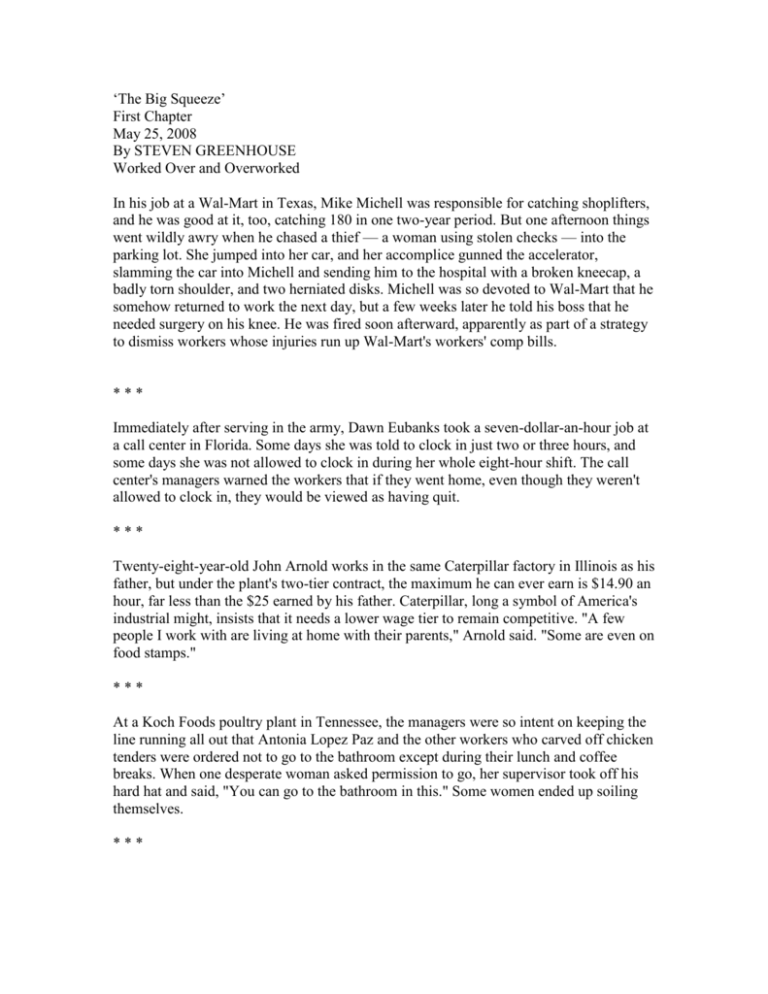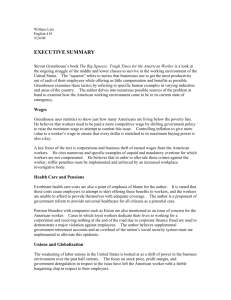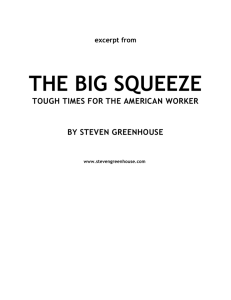
‘The Big Squeeze’
First Chapter
May 25, 2008
By STEVEN GREENHOUSE
Worked Over and Overworked
In his job at a Wal-Mart in Texas, Mike Michell was responsible for catching shoplifters,
and he was good at it, too, catching 180 in one two-year period. But one afternoon things
went wildly awry when he chased a thief — a woman using stolen checks — into the
parking lot. She jumped into her car, and her accomplice gunned the accelerator,
slamming the car into Michell and sending him to the hospital with a broken kneecap, a
badly torn shoulder, and two herniated disks. Michell was so devoted to Wal-Mart that he
somehow returned to work the next day, but a few weeks later he told his boss that he
needed surgery on his knee. He was fired soon afterward, apparently as part of a strategy
to dismiss workers whose injuries run up Wal-Mart's workers' comp bills.
***
Immediately after serving in the army, Dawn Eubanks took a seven-dollar-an-hour job at
a call center in Florida. Some days she was told to clock in just two or three hours, and
some days she was not allowed to clock in during her whole eight-hour shift. The call
center's managers warned the workers that if they went home, even though they weren't
allowed to clock in, they would be viewed as having quit.
***
Twenty-eight-year-old John Arnold works in the same Caterpillar factory in Illinois as his
father, but under the plant's two-tier contract, the maximum he can ever earn is $14.90 an
hour, far less than the $25 earned by his father. Caterpillar, long a symbol of America's
industrial might, insists that it needs a lower wage tier to remain competitive. "A few
people I work with are living at home with their parents," Arnold said. "Some are even on
food stamps."
***
At a Koch Foods poultry plant in Tennessee, the managers were so intent on keeping the
line running all out that Antonia Lopez Paz and the other workers who carved off chicken
tenders were ordered not to go to the bathroom except during their lunch and coffee
breaks. When one desperate woman asked permission to go, her supervisor took off his
hard hat and said, "You can go to the bathroom in this." Some women ended up soiling
themselves.
***
Don Jensen anticipated a relaxing life of golf after retiring from his human resources post
with Lucent Technologies in New Jersey, where he was in charge of recruiting graduates
from Stanford, Cornell, MIT, and other top universities. But when Lucent increased its
retirees' health insurance premiums to $8,280 a year, up from $180, Jensen was forced to
abandon his retirement. He took a job as a ten-dollar-an-hour bank teller.
***
As part of her software company's last-lap sprint to get new products out the door, Myra
Bronstein sometimes had to work twenty-four hours straight testing for bugs. She felt
great loyalty to the Seattle-area company because its executives had repeatedly promised,
"As long as we're in business, you have a job." But one Friday morning the company
suddenly fired Bronstein and seventeen other quality assurance engineers. The engineers
were told that if they wanted to receive severance pay, they had to agree to spend the next
month training the workers from India who would be replacing them.
One of the least examined but most important trends taking place in the United States
today is the broad decline in the status and treatment of American workers — whitecollar and blue-collar workers, middle-class and low-end workers — that began nearly
three decades ago, gradually gathered momentum, and hit with full force soon after the
turn of this century. A profound shift has left a broad swath of the American workforce
on a lower plane than in decades past, with health coverage, pension benefits, job
security, workloads, stress levels, and often wages growing worse for millions of
workers.
That the American worker faces this squeeze in the early years of this century is
particularly troubling because the squeeze has occurred while the economy, corporate
profits, and worker productivity have all been growing robustly. In recent years, a
disconcerting disconnect has emerged, with corporate profits soaring while workers'
wages stagnated.
The statistical evidence for this squeeze is as compelling as it is disturbing. In 2005,
median income for nonelderly households failed to increase for the sixth year in a row,
after factoring in inflation. That is unprecedented in a time of economic growth. In 2006,
median income for those households did finally rise, but it still remained lower — $2,375
lower — than seven years earlier. That, too, is unprecedented. Even though corporate
profits have doubled since recession gave way to economic expansion in November
2001, and even though employee productivity has risen more than 15 percent since then,
the average wage for the typical American worker has inched up just 1 percent (after
inflation). With the subprime mortgage crisis threatening to pull the economy into
recession, some economists say this may be the first time in American history that the
typical working household goes through an economic expansion without any increase in
income whatsoever.
This, unfortunately, is the continuation of a long-term squeeze. Since 1979, hourly
earnings for 80 percent of American workers (those in private-sector, nonsupervisory
jobs) have risen by just 1 percent, after inflation. The average was was $17.71 at the end
of 2007. For male workers, the average hourly wage actually slid by 5 percent since
1979. Worker productivity, meanwhile, climbed 60 percent. If wages had kept pace with
productivity, the average full-time worker would be earning $58,000 a year; $36,000 was
the average in 2007. The nation's economic pie is growing, but corporations by and large
have not given their workers a bigger piece.
The squeeze on the American worker has meant more poverty, more income inequality,
more family tensions, more hours at work, more time away from the kids, more families
without health insurance, more retirees with inadequate pensions, and more demands on
government and taxpayers to provide housing assistance and health coverage. Twenty
percent of families with children under six live below the poverty line, and 22 million
full-time workers do not have health insurance. Largely as a result of the squeeze, the
number of housing foreclosures and personal bankruptcies more than tripled in the
quarter century after 1979. Economic studies show that income inequality in the United
States is so great that it more closely resembles the inequality of a third world country
than that of an advanced industrial nation.
Many families are enjoying higher incomes, enabling them to buy a plasma-screen TV or
take a vacation in Orlando, but this is frequently because fathers have taken on second
jobs or more overtime hours or because mothers, even with toddlers, have opted for fulltime paid employment. Millions of households have not slipped further behind only
because Americans are working far harder than before. A husband and wife in the
average middle-class household are, taken together, working 540 hours or three months
more per year than such couples would have a quarter century ago, largely because
married women are working considerably longer hours than before.
Viewed another way, the American worker's financial squeeze has translated into a time
squeeze. In a survey by the Families and Work Institute, two-thirds of employed parents
responded that they didn't have enough time with their kids, and just under two-thirds
said they didn't have enough time with their spouses. The typical American worker toils
1,804 hours a year, 135 hours more per year than the typical British worker, 240 hours
more than the average French worker, and 370 hours (or nine full-time weeks) more than
the average German worker. No one in the world's advanced economies works more.
Aggravating the time squeeze is a phenomenon known as job creep in which our jobs
have spilled increasingly into our leisure time. Americans are finishing work memos on
their home computers at eleven p.m., they are reading office e-mails on Saturdays and
Sundays, and they are using their cell phones and BlackBerries to answer their bosses'
queries while on vacation. The Conference Board, the business research group, found that
Americans are less satisfied with their jobs — just 47 percent are satisfied — than at any
time since it started tracking the numbers two decades ago. "The breadth of
dissatisfaction is unsettling," the Conference Board wrote, its director of research adding,
"The demands in the workplace have increased tremendously."
Americans are going deeper into debt than ever before. Millions of households have
supersized their credit card balances, and many have taken cash out of their homes by
obtaining second mortgages, arguably unhealthy ways to try to maintain a comfortable
lifestyle on a less-than-comfortable income. In 2005, for the first time since the Great
Depression, the nation's personal savings rate sank below zero, meaning that Americans
were actually spending more than they were earning. As a result, among the bottom twofifths of households, nearly one in four spends at least 40 percent of its monthly income
paying down its debts. And foreclosure filings, spurred by the subprime mortgage crisis,
were expected to soar to as many as two million in 2007. Two million foreclosures would
represent one in sixty-two households.
Even as wages stagnated in recent years, many government officials triumphantly boasted
that consumer spending had continued to rise. But this increase was largely due to
soaring incomes at the top. From 1979 to 2005, after-tax income inched up just 6 percent
for the bottom fifth of American households after accounting for inflation, while it rose
21 percent for the middle fifth. For the top fifth, income jumped 80 percent and for the
top 1 percent it more than tripled, soaring by 228 percent. A 2007 report by the
Congressional Budget Office found that the top 1 percent of households had pre-tax
income in 2005 that was more than two-fifths larger than that of the bottom 40 percent.
(After taxes, the top 1 percent's income in 2005 was still nearly 10 percent more than the
bottom 40 percent's.) As Paul Krugman wrote, "It's a great economy if you're a high-level
corporate executive or someone who owns a lot of stock. For most other Americans,
economic growth is a spectator sport."
The nation appears to be on the threshold of recession, and as a result, America's workers
are likely to be squeezed not just by stagnant wages but also by rising unemployment.
One of the most worrisome — and puzzling — aspects of the economic expansion that
began in November 2001 is that wages have remained stubbornly flat, after factoring in
inflation, even though the jobless rate has been low by historical standards. That wages
have gone nowhere in a tight labor market underlines the American worker's declining
ability to command higher wages, and now with unemployment increasing, workers'
leverage to push for higher wages is bound to grow even weaker.
The squeeze is of course worst for those on the lowest rungs, including millions of
workers who are part of our everyday lives: fast food workers, cashiers, child care
workers, hotel maids, and nurse's aides. Nearly 33 million workers — almost one-fourth
of the American workforce — earn less than ten dollars an hour, meaning their wages
come to less than the poverty line for a family of four ($20,614 in 2006). Despite strong
economic growth, the number of Americans living in poverty jumped by 15 percent from
2000 to 2006 — an increase of 5.4 million to 36.5 million. For millions of low-income
workers, the promise of America has been broken: the promise that if you work hard, you
will be rewarded with a decent living, the promise that if you do an honest day's work,
you will earn enough to feed, clothe, and shelter your family.
Not only do workers on the bottom rungs lack money, but they often lack basic benefits.
Three out of four low-wage workers in the private sector do not have employer-provided
health insurance, while eight out of nine do not participate in a pension plan. Threefourths of low-wage workers do not receive paid sick days, so if they need to miss two
days "work because they are sick or their child is sick, they receive no pay for those days
and often risk getting fired.
A study sponsored by the Ford, Rockefeller, and Annie E. Casey foundations, "Working
Hard, Falling Short," concluded "More than one out of four American working families
now earn wages so low" — defined as income of less than twice the poverty line for a
family of four ($41,200 in 2006) — "that they have difficulty surviving financially." The
study continued, "While our economy relies on the service jobs these low-paid workers
fill ... our society has not taken adequate steps to ensure that these workers can make ends
meet and build a future for their families, no matter how determined they are to be selfsufficient." In her book Nickel and Dimed, Barbara Ehrenreich described these workers
as "the major philanthropists of our society." Ehrenreich wrote, "They neglect their own
children so the children of others will be cared for; they live in substandard housing so
that other homes will be shiny and perfect." Across America more than 50 million people
live in near poor households, those with incomes between $20,000 and $40,000 a year.
Katherine Newman, a Princeton sociologist, has described this large but often overlooked
group as "the missing class." The mass of workers who are barely getting by is likely to
grow only larger, because the Bureau of Labor Statistics forecasts that low-wage jobs will
account for six of the top ten categories in overall job growth between now and 2014:
janitors, nursing home aides, waiters, home-health aides, retail sales workers including
cashiers, and food-prep and fast food workers.
America's ailing health care system is a big part of the worsening squeeze. From 2000 to
2006, the number of Americans without health insurance climbed by 8.6 million, to 47
million. One study found that more than two-fifths of moderate-income, working-age
Americans went without health insurance for at least part of 2005. Not only that, for
employees who want coverage, companies are requiring them to pay more for it, and as a
result, the cost of family coverage has soared 83 percent in just six years. As health costs
consume more and more of the nation's economic output — they account for 16 percent
of gross domestic product, or GDP, up from 5 percent in 1960 — that necessarily leaves
less money for wage increases.
Pensions, the other pillar of employee benefits, are under assault as never before. In May
2005, a bankruptcy judge allowed United Airlines to default on its pension plans and
dump them on the federal agency that protects retirement benefits. Because that agency
guarantees pensions only up to a certain amount, many United pilots will receive only
half what they expected when they retire. United's move was the biggest pension default
in American history, releasing it from paying $3.2 billion in obligations over the
following five years. One of United's lawyers predicted that more and more companies
would use this "strategic tool" to increase their competitiveness. Since then, US Airways
and Delta have followed suit. When Delphi, the auto parts giant, filed for bankruptcy in
October 2005, its chief executive, Robert S. Miller, threatened to slash the company's
pensions unless the workers agreed to massive wage concessions.
As part of this assault on pensions, Hewlett-Packard, IBM, Verizon, Sears, Motorola, and
many other companies have embraced a riskier, far less generous type of retirement plan,
401(k)s, while turning away from the traditional plans that promised workers a specific
monthly benefit for life after they retired. When Hewlett-Packard took that step, a
company spokesman said, "Pension plans are kind of a thing of the past."
With pensions growing ever scarcer, more and more workers are convinced that they
won't have enough money to retire. Ominously, some economists have begun to warn
that millions of Americans might have to continue working into their seventies.
Even though this is an era of increased economic volatility, the federal government has
decided to let Americans fend increasingly for themselves. Just one-third of laid-off
workers receive unemployment benefits, down from 50 percent a generation ago. And
even though workers' skills are becoming obsolete faster than ever because of new
technologies and globalization, funding for the main federal program for retraining has
been reduced by more than $10 billion in the last quarter century. "Americans
increasingly find themselves on an economic tightrope, without an adequate safety net if
— as is ever more likely — they lose their footing," wrote Jacob S. Hacker, author of The
Great Risk Shift.
(Continues...)
Excerpted from The Big Squeeze by Steven Greenhouse Copyright 2008 by Steven
Greenhouse. Excerpted by permission. All rights reserved. No part of this excerpt may be
reproduced or reprinted without permission in writing from the publisher. Excerpts are
provided by Dial-A-Book Inc. solely for the personal use of visitors to this web site.







